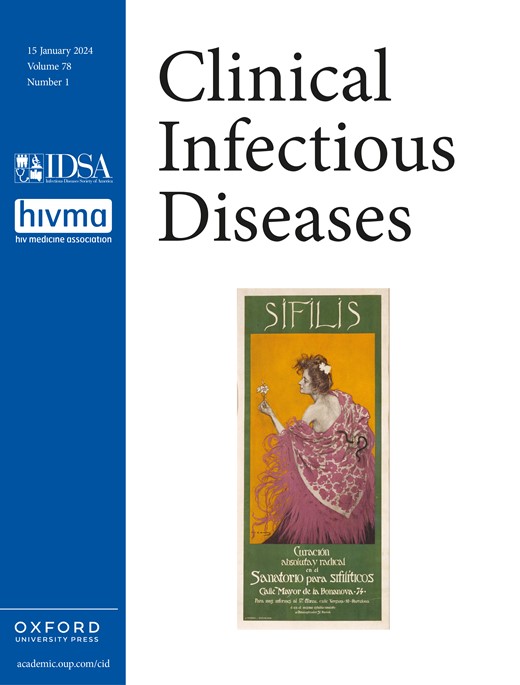医院-家庭和粪便微生物群移植治疗老年艰难梭菌患者的成本-效果。
IF 8.2
1区 医学
Q1 IMMUNOLOGY
引用次数: 0
摘要
背景艰难梭菌感染(CDI)主要影响有合并症的老年患者,死亡率高。粪便菌群移植(FMT)是治疗CDI的一种有效且经济的方法。在最近的一项研究中,我们证明了将医院家庭护理与FMT结合治疗老年CDI患者的临床益处,但其成本效益尚不清楚。目前的研究旨在评估≥70岁CDI患者的干预与标准治疗的成本效益。方法采用一项纳入217例患者的随机临床试验数据进行成本-效用分析,评估90天内干预的成本-效果。从保健部门的角度评估了资源使用情况。对缺失数据采用代理替换和多次插值的方法进行处理。敏感性分析包括概率分析、完整病例分析、关键单价调整和医院视角。每个质量调整生命年(QALY)的支付意愿门槛设定为22 994欧元或24 863美元。结果在基本案例分析中,干预措施占主导地位,平均成本节省2556欧元(2764美元),平均获得0.004 QALY。虽然资源使用较高,但干预导致每位患者平均减少6天住院时间,并增加临床缓解的几率。从不同的角度来看,排除了数据缺失的患者,以及住院费用的变化,结果仍然是稳健的。结论在年龄≥70岁的CDI患者中,与标准治疗相比,结合医院家庭护理和FMT的干预具有成本效益。成本效益主要是由于住院天数减少。本文章由计算机程序翻译,如有差异,请以英文原文为准。
Cost-Effectiveness of Hospital-at-Home and Fecal Microbiota Transplantation in Treating Older Patients With Clostridioides difficile.
BACKGROUND
Clostridioides difficile infection (CDI) primarily affects older patients with comorbid conditions and has a high mortality rate. Fecal microbiota transplantation (FMT) is effective and cost-effective for CDI. In a recent study, we demonstrated the clinical benefits of combining hospital-at-home care with FMT for older patients with CDI, but its cost-effectiveness remains unknown. The current study aimed to evaluate the cost-effectiveness of the intervention in patients aged ≥70 years with CDI, compared with standard treatment.
METHODS
The cost-utility analysis was conducted using data from a randomized clinical trial enrolling 217 patients, assessing the cost-effectiveness of the intervention over 90 days. Resource use was assessed from a healthcare sector perspective. Missing data were handled with proxy replacement and multiple imputation. Sensitivity analyses included probabilistic analysis, complete case analysis, adjustment of key unit prices, and a hospital perspective. A willingness-to-pay threshold was set to €22 994 or $24 863 per quality-adjusted life year (QALY).
RESULTS
In the base case analysis, the intervention was dominant, with mean cost savings of €2556 ($2764) and a mean gain of 0.004 QALY. Although resource use was higher, the intervention resulted in an average reduction of 6 hospital admission days per patient and increased odds of clinical resolution. The results remained robust across different perspectives, the exclusion of patients with missing data, and variations in hospital admission costs.
CONCLUSIONS
In patients aged ≥70 years with CDI, an intervention combining hospital-at-home care and FMT is cost-effective compared with standard treatment. The cost-effectiveness is mainly driven by fewer hospital admission days.
求助全文
通过发布文献求助,成功后即可免费获取论文全文。
去求助
来源期刊

Clinical Infectious Diseases
医学-传染病学
CiteScore
25.00
自引率
2.50%
发文量
900
审稿时长
3 months
期刊介绍:
Clinical Infectious Diseases (CID) is dedicated to publishing original research, reviews, guidelines, and perspectives with the potential to reshape clinical practice, providing clinicians with valuable insights for patient care. CID comprehensively addresses the clinical presentation, diagnosis, treatment, and prevention of a wide spectrum of infectious diseases. The journal places a high priority on the assessment of current and innovative treatments, microbiology, immunology, and policies, ensuring relevance to patient care in its commitment to advancing the field of infectious diseases.
 求助内容:
求助内容: 应助结果提醒方式:
应助结果提醒方式:


